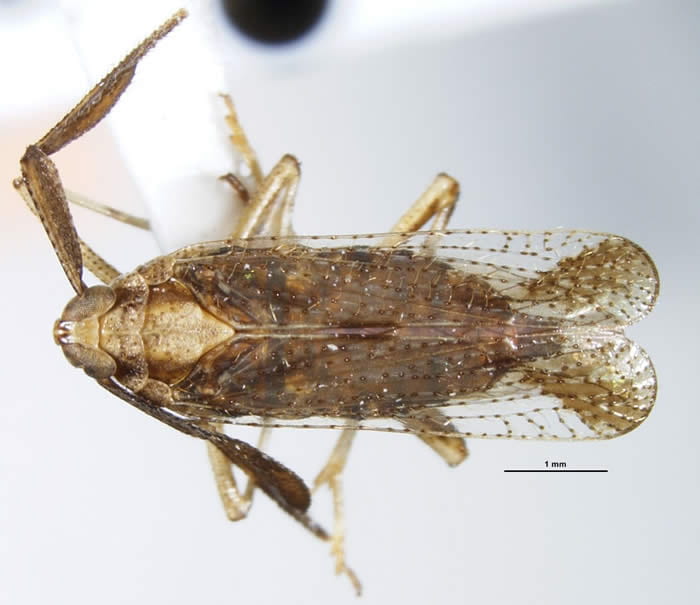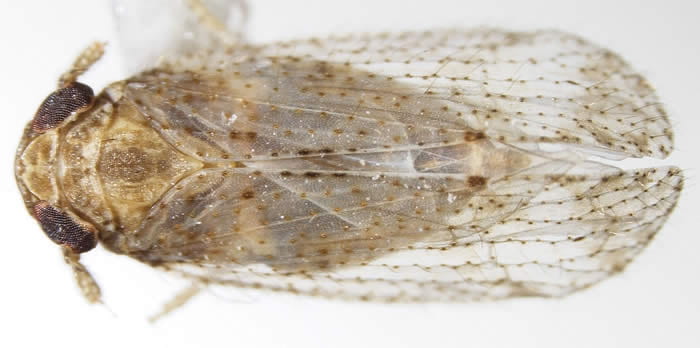[Back to Higher classification of Delphacidae]
Family Delphacidae Leach, 1815
Subfamily Asiracinae Motschulsky 1863
This subfamily is the most basal (i.e., primitive) of the subfamilies and generally possesses a series of features that are plesiomorphic features for the family. The simplest way to recognize the subfamily is that the calcar is spinelike (not flattened) and lacks teeth (see #3 of the list below). There are a series of additional features and these are briefly described and illustrated below.
The composition of the subfamily is as follows (see here for list of genera)
Subfamily Asiracinae Motschulsky 1863: 108
Tribe Asiracini Fieber, 1872: 5 (6 genera, 1 New World [Copicerus] and one doubtfully in New World [Asiraca])
Tribe Eodelphacini Emeljanov, 1995 (10 genera; none in New World)
Tribe Idiosystatini Emeljanov, 1995 (3 genera, entirely New World; Idiosemus; Idiosystatus; Pentagramma)
Tribe Neopunanini Emeljanov, 1995 (1 genus, entirely New World: Neopunana)
Tribe Platysystatini Emeljanov, 1995 (4 genera; entirely New World: Equasystatus; Pentasteira; Pichinchana; Platysystatus)
Tribe Tetrasteirini Emeljanov, 1995 (1 genus, entirely New World: Tetrasteira)
Tribe Ugyopini Fennah, 1979 (6 genera; 2 partly or entirely New World: Canyra; Ugyops)
Distribution
Features
1. Oblique genal carina may be absent (present is derived).
- If present, genal carina extending from lateral frontoclypeal edge to posterior edge or behind antenna (to anterior edge of antenna is derived).

Head of Pentagramma from Asche 1985. The genal carina extends from the frontoclypeal suture in an arc beneath the antennal socket to the eye.
2. Tymbal similar in males and females (sexual dimorphism is derived).
- “Central plate” of second abdominal tergum absent (present is derived).
- Second abdominal tergite without deep central depression (with deep depression is derived).
- Apodemes of metapostnotum not elongate (elongate is derived).
- Apodemes of second abdominal sternite weakly developed (developed is derived).
3. Hind leg
- Apical spines of hind tibiae forming continuous row and similarly shaped (differentiated into 2 groups is derived).
- Three or more lateral spines (2 is derived).
- Apical spines of first tarsomere (basitarsus) in continuous row (2 groups is derived); median of distal spines not shifted proximally.
- Calcar spine-like (rounded or quadrate) without teeth (flattened with teeth is derived – All delphacids more advanced than the Vizcayinae have a flattened, usually foliaceous calcar).

In Delphacinae, the calcar is flattened, tectiform, and usually bearing teeth on the posterior (trailing) surface; here is Delphax pulchellus and Nilaparvata lugens from Asche 1985
4. Vertex
- Fastigium angular (rounded is derived).
- Carinae of vertex conspicuous forming two large basal compartments and a small areolet (this feature contrasts primitive Asiracinae with Vizcayinae, extensively modified in more advanced groups).
5. Antennae
- Segments short and cylindrical, similar in shape and length (this feature postulated, partly from antennal ontogeny, see Asche 1985; elongate and differentiated antennal segments derived).
- Number of rhinaria (sensory fields) equal or greater than 16 in irregular arrangement (arrangement in regular rows is derived).
6. Number of larval sensory pits on frons and vertex of nymph
- Variable, often greater than 18 total (fixed at 18 – 9 per side – is derived).
7. Hind wing
- 5 veins arise from hind wing nodal line (RA, RP, M1+2, M3+4, CuA) (M not forked, or forked after nodal like is advanced).
- M and CuA widely separated prior to nodal line.

Key to genera of New World Asiracinae delphacid planthoppers (from Barringer & Bartlett 2011) (Pichinchana not included)
1. Head greatly elongate, extending in front of eye for a distance greater than the length of the eye; Chile, Argentina, Uruguay … Idiosemus
1’ Head not greatly elongate … 2
2. Antennae with both segments very long, flattened, and foliaceous, exceeding apex of mesonotum; widespread … Copicerus
2’ Antennae with segments terete, if flattened then antennae short, not reaching apex of mesonotum … 3
3. Frons with median carina paired for entire length … 4
3’ Frons with median carina single … 5
4. Body pale, usually greenish; fastigium rounded in lateral view; carinae of frons usually concolorous with disk; wings without conspicuous setae; widespread, mostly temperate … Pentagramma
4’ Body dark, brownish; fastigium angled in lateral view; carinae of frons paler than disk; wings with conspicuous setae; Argentina, Chile … Idiosystatus
5. Smaller species, mostly less than 5 mm (usually less than 4 mm); antennae short, not exceeding midlength of mesonotum; first segment about as long as wide, second segment longer than wide; frons broad, usually with rounded lateral margins; calcar usually rounded in cross section bearing scattered hairs … 6
5’ Large species, exceeding 6 mm; antennae long exceeding midlength of mesonotum, first segment more than 2x longer than wide, second segment subequal or longer than first; frons elongate; calcar quadrate in cross section bearing hair in rows … 10
6. Intermediate carinae of mesonotum diverging (uniformly arched or straight), median mesonotal carina absent; antennae terete, fastigium without transverse carina, lateral margins of frons weakly rounded … Tetrasteira
6’ Intermediate carinae of mesonotum sinuate, median carina usually present; first antennal segment often flattened; transverse carina may be present at fastigium (weak in Neopunana), frons broadly rounded laterally, lateral margins strongly arched … 7
7. Body length, including wings, greater than 5 mm, body distinctly dorsoventrally flattened; calcar bearing rows of hairs; Caribbean … Neopunana
7’ Body length, including wings, less than 4 mm; body not or weakly flattened; calcar with scattered hairs; South America … 8
8. Antennae terete in cross-section; frons in frontal view convex between eye and laterally projecting beneath eyes to cover (or nearly cover) the base of scape; Brazil … Platysystatus
8’. Antennae flattened in cross-section; frons in frontal view not (or weakly) convex and weakly projecting laterally beneath eyes, not covering base of scape … 9
9. Intermediate carinae of mesonotum serpentine, frons laterally rounded, aedeagus with stout flagellum; body color light brown mottled with pale, lacking broad white stripe on frons … Equasystatus
9’. Intermediate carinae of mesonotum uniformly arched, frons peltate, aedeagus with fine flagellum; body deep brown with broad white stripe along frontoclypeal suture … Pentasteira
10. First antennal segment sulcate, with dorsal longitudinal concavity … Canyra
10’ First antennal segment terete, lacking concavity … Ugyops
Selected References
[The following list is skeletal; more references still to come]
Asche, M. 1983a. Zur Kenntnis der Gattung Platysystatus Muir, 1930 (Homoptera Auchenorrhyncha Fulgoromorpha Delphacidae). Marburger Entomologische Publikationen 1(8): 107-126.
Asche, M. 1983b. Aufgliederung der Asiracinen-Gattung Punana Muir, 1913: Equasystatus gen. nov. aus Equador und Neopunana gen. nov. von den Karibischen Inseln (Homoptera Auchenorrhyncha Fulgoromorpha Delphacidae). Marburger Entomologische Publikationen 1(8): 127-166.
Asche, M. 1985. Zur Phylogenie der Delphacidae Leach, 1815 (Homoptera: Cicadina: Fulgoromorpha). Marburger Entomologische Publikationen 2(1): 1-398 AND 2(2): 399-910.
Asche, M. and M. D. Webb. 2013. A remarkable new asiracine delphacid planthopper from Ecuador (Hemiptera, Fulgoroidea, Delphacidae). Deutsche Entomologische Zeitschrift 60(2): 163-169.
Barringer, L. E. and C. R. Bartlett. 2011. A review of New World Asiracinae (Hemiptera: Auchenorrhyncha: Delphacidae) with five new taxa. Cicadina 12: 7-39.
Dlabola, J. 1965. A new Elaphodelphax, further species of Asiracinae from Africa (Homoptera Auchenorrhyncha). Acta Faunistica Entomologica Musei Nationalis Pragae 36: 475-488.
Donaldson, J. F. 1979. Revision of the genus Notuchus Fennah (Homoptera: Fulgoroidea: Delphacidae). Journal of the Australian Entomological Society 18(2): 181-185.
Donaldson, J. F. 1983. Revision of the Australia Asiracinae (Homoptera: Fulgoroidea: Delphacidae). Journal of the Australian Entomological Society 22(4): 277-285.
Donaldson, J. F. 1987. Notuchus howensis sp. n. (Homoptera: Fulgoroidea: Delphacidae) from Lord Howe Island. Journal of the Australian Entomological Society 26(1): 81-83.
Donaldson, J. F. 1988. Further studies on Asiracinae (Homoptera: Delphacidae) in Australia and New Caledonia. Journal of the Australian Entomological Society 27(2): 133-141.
Emeljanov, A. F. 1995. On the question of the classification and phylogeny of the Delphacidae (Homoptera, Cicadina), with reference to larval characters. Entomologicheskoe Obozrenie 74(4): 780-794 [in Russian, English translation in Entomological Review (1996) 75(9):134-150). (PDF of English version)
Fennah, R. G. 1972. A new species of Notuchus (Homoptera, Fulgoroidea,
Delphacidae) from Lord Howe Island. Records of the Australian Museum 28 (13): 265–267.
Fennah, R. G., 1980. A cavernicolous new species of Notuchus from New Caledonia (Homoptera: Fulgoroidea: Delphacidae). Revue suisse Zoologie 87 (3): 757–759.
Leach, W. E. 1815a. Entomology. The Edinburg encyclopedia; conducted by David Brewster 9: 57-172. (family Delphacidae page 125).
Llano, C. A., C. R. Bartlett and G. Guevara. 2016. First record of the subfamily Asiracinae and Copicerus irroratus (Hemiptera: Auchenorrhyncha: Delphacidae) in Colombia. Florida Entomologist 99(1): 120-122.
De Motschulsky, V. I. 1863. Essai d’un catalogue des insectes de l’ile de Ceylan. Bulletin de la Société Impériale des Naturalistes de Moscou 36: 1-153. (p. 108).
Muir, F.A.G. 1926b. Contributions to our knowledge of South American Fulgoroidea (Homoptera). Part I. The family Delphacidae. Experiment Station of the Hawaiian Sugar Planters’ Association, Entomological Series, Bulletin 18: 1-51, plates 1-5.
Yang, J. T. and C. T. Yang. 1986. Delphacidae of Taiwan (1) Asiracinae and the tribe Tropidocephalini (Homoptera: Fulgoroidea). Taiwan Museum Special Publication Series 6: 1-79.
Yang, J. T., C. T. Yang and K. T. Shao. 1987. Numerical taxonomic studies on the Asiracinae and Tropidocephalini Fulgoroidea Delphacidae from Taiwan. Bulletin of the Institute of Zoology Academia Sinica (Taipei) 26(3): 215-230.





















